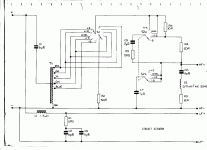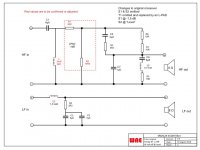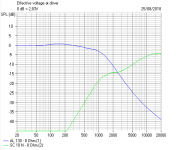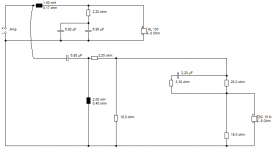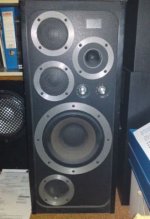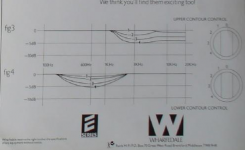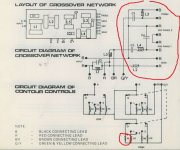SRM12X crossover alternative
With the help of the more knowledgable in this forum and reading proposed documentation, I am trying to understand the principles of a crossover.
Came up with the next version (see attachments in this order);
1 - The original (I own 1)
2 - Replacing the rotation switches S1 and S2 for a fixed wiring solution. The switches can be seen replaced on all Tannoy model from around '80's by (as far as I understand gold-plated screw solutions).
3 - Replacing the autoformer / coil solution for a simplified setup, using an L-PAD.
Think I'm going to decide on brands and types of components, find a web-shop and order. Must be starting sometime.
Improvement suggestions always welcome.
kind regards.
With the help of the more knowledgable in this forum and reading proposed documentation, I am trying to understand the principles of a crossover.
Came up with the next version (see attachments in this order);
1 - The original (I own 1)
2 - Replacing the rotation switches S1 and S2 for a fixed wiring solution. The switches can be seen replaced on all Tannoy model from around '80's by (as far as I understand gold-plated screw solutions).
3 - Replacing the autoformer / coil solution for a simplified setup, using an L-PAD.
Think I'm going to decide on brands and types of components, find a web-shop and order. Must be starting sometime.
Improvement suggestions always welcome.
kind regards.
Attachments
I just ran a sim to see if I could estimate what that tweeter filter does. Crossover around 2kHz. It looks like a simple step on the tweeter to allow for the typical 6dB low down gain of a horn tweeter between 2-5kHz.
In fact the main event is the 2.2uF/3.3R in parallel with 20 ohms to do this. Into approx. 6 ohms tweeter.
You can do much the same with a few resistors and the 2.2uF! I could probably simplify it further. The dotted line is the simpler circuit. The main line is your proposed circuit.
In fact the main event is the 2.2uF/3.3R in parallel with 20 ohms to do this. Into approx. 6 ohms tweeter.
You can do much the same with a few resistors and the 2.2uF! I could probably simplify it further. The dotted line is the simpler circuit. The main line is your proposed circuit.
Attachments
I just ran a sim to see if I could estimate what that tweeter filter does. Crossover around 2kHz.
The dotted line is the simpler circuit. The main line is your proposed circuit.
Hi Steve,
Nice to see your on to this. Maybe for now we'll settle with this version. I need to start building the cabinet and see what this brings compared to the original crossover I also have (just one). I could compare the original in the same setting as this version of the crossover and listen what a new version without the components I did not like compares to.
As said earlier, I don't like switches in a crossover, so wanted to get rid of them anyhow. We succeeded (well, you did) in that. The autoformer is OK if you want to be flexible and even "uplift" a signal. I don't see any need for that, the HF with the little horn inside the Dual Concentric is way more efficient anyway, then why crank it up even further.
Detail, you mentioned a dotted line, I'm afraid I don't see a dotted line in the filter drawing you posted.
kind regards.
It's all a bit "suck it and see"! 🙂
You are right, it's hard to see the dotted line. It's about 1dB below the original green one:
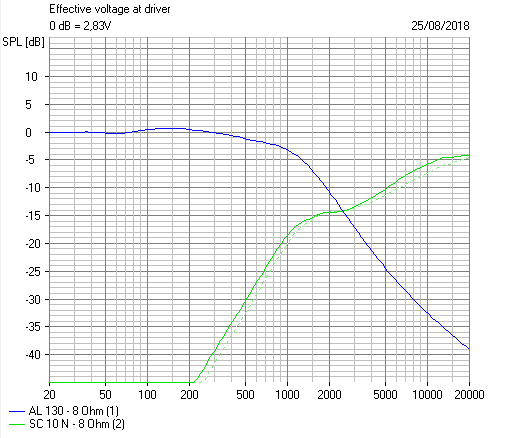 .
.
I have diddled with this sort of problem before. The excellent Wharfedale E70 had some user tone adjust. In level form, it reduced to the easy circuit outlined in red. The slightly complicated elements just got switched out of circuit. Don't know why Wharfedale bothered really. 😀
You are right, it's hard to see the dotted line. It's about 1dB below the original green one:
I have diddled with this sort of problem before. The excellent Wharfedale E70 had some user tone adjust. In level form, it reduced to the easy circuit outlined in red. The slightly complicated elements just got switched out of circuit. Don't know why Wharfedale bothered really. 😀
Attachments
Seems we're not the only ones that stumble into the same issue and make a big fuzz about it. Makes me think at least 10% of us people over the entire globe are constantly (well sort off) working on the same issues coming up with mostly the same or slight variations of answers. Mind you, we think we're the most intelligent animal on this planet. Being busy ehhh..? 🙄
Thats just me.....
kind regards.
Thats just me.....
kind regards.
Don't know if it helps at this stage or already mentioned but the inductive and resistive values of the autoformer taps are roughly like this apparently:
Blue - 2mH, 0.6Ω
Green - 3mH, 0.7Ω
Yellow - 4mH, 0.8Ω
Orange - 6mH, 1.0Ω
Red - 9mH, 1.2Ω
Also it seems ok to go below the ohmic value but not above (don't ask me I only know enough about the details of passive crossovers to be dangerous).
Thanks to Hans Hilberink of the Tannoy Yahoo group
Blue - 2mH, 0.6Ω
Green - 3mH, 0.7Ω
Yellow - 4mH, 0.8Ω
Orange - 6mH, 1.0Ω
Red - 9mH, 1.2Ω
Also it seems ok to go below the ohmic value but not above (don't ask me I only know enough about the details of passive crossovers to be dangerous).
Thanks to Hans Hilberink of the Tannoy Yahoo group
autoformer
Thanks,
Charles. They come close to other measurements I've seen.
Depending on the schema we want to use, we could use these as replacing coil .
To be decided.
kind regards.
Thanks,
Charles. They come close to other measurements I've seen.
Depending on the schema we want to use, we could use these as replacing coil .
To be decided.
kind regards.
No measurements on the HF yet, just did a check on the LF to calculate the BR for it.
Will do.
Currently very busy for the weekend, need to do a sound engineering job on the "Supertramp Revival band". Need so extra stuff to get working.
kind regards.
Will do.
Currently very busy for the weekend, need to do a sound engineering job on the "Supertramp Revival band". Need so extra stuff to get working.
kind regards.
Sorry to hear that! 🙂
Couldn't stand the original so doing their covers band would be like a nightmare to me.
Couldn't stand the original so doing their covers band would be like a nightmare to me.
This thread started with me being all hyped up about finally having a pair of Tannoy DC's from the early 80's.
Then all hell broke loose, because we always want to make the original better, for good reasons mostly.
So I decided to split up the thread,
- use the old K3149 (reconed) for the original SRM12X (this thread)
- and go for a 3-way DC aiming at studio usage. It's called to PM-DMT because the new thread started with de Tannoy DMT as an example.
Anyway, THIS thread is all about building the SRM12X, as in the attached picture.
I do need to double check on the dimensions, but guess this will be the own.
Will build it using good quality MDF and apply a veneer job. The grey area's is bracing, hey some detail changes is OK isn't it. Also need to work on the cross-over, only have one 😱
to be continued,
kind regards.
Small aside; Years ago my next door neighbour was proud as punch that he had just bought a pair of These exact SRMs.
Tiring of his ongoing babbles..invited him over to Hear My Golds .
He was astounded at the sound quality differences.
Just saying.
When I spoke to Roger Lockwood of Lockwood Audio he told me that after working with Tannoy for nay on 50 years the K series are the best drivers Tannoy ever made and getting rid of the autoformer a good way to improve them.
Just sayin...
Just sayin...
Of Course he did 🙄
When I worked at the Canadian Broadcast Corp (early70's) We bought 3000! pairs of Tannoy Golds in 12" size. Our engineers developed a bespoke Xover and a Bespoke cabinet to meet needs.
Sent off for evaluation CAL Patented the design and subsequently sold the copy as their 'manley' speaker.. for years. Arguable as to where SRM got it's design from.
Gotta Love the Audio Business. Integrity is clearly rare.
Same time BBC tried to sell their goofy LS3a (?) speakers.
Unanimous response amongst us who would actually use them:
they were unmitigated Crap.. period. Consequently Zero were bought.
Tannoy (decades and several owners) later , vying for another big sale tried to pawn off K series drivers.. again a resounding: these aren't good enough to buy.
WHO cares what some ancilliary business hanger on workie Claims.
Broadcast Pros didn't think enough of their sounds to warrant their purchase..
Notwithstanding British Jingoism 😉
When I worked at the Canadian Broadcast Corp (early70's) We bought 3000! pairs of Tannoy Golds in 12" size. Our engineers developed a bespoke Xover and a Bespoke cabinet to meet needs.
Sent off for evaluation CAL Patented the design and subsequently sold the copy as their 'manley' speaker.. for years. Arguable as to where SRM got it's design from.
Gotta Love the Audio Business. Integrity is clearly rare.
Same time BBC tried to sell their goofy LS3a (?) speakers.
Unanimous response amongst us who would actually use them:
they were unmitigated Crap.. period. Consequently Zero were bought.
Tannoy (decades and several owners) later , vying for another big sale tried to pawn off K series drivers.. again a resounding: these aren't good enough to buy.
WHO cares what some ancilliary business hanger on workie Claims.
Broadcast Pros didn't think enough of their sounds to warrant their purchase..
Notwithstanding British Jingoism 😉
Last edited:
Of Course he did 🙄
When I worked at the Canadian Broadcast Corp (early70's) We bought 3000! pairs of Tannoy Golds in 12" size. ..... SNIP ......
Notwithstanding British Jingoism 😉
Hey Bare,
We all have our preferences, I (and some others with me) have a soft spot for Tannoy's and the Coaxial / DC driver concepts. You can build very nice loudspeakers with them, but of-course can do it all wrong.
I'm merely posting the thread, because I could get hold of these 2 K3149's. Just for my own fun, wanted to re-create the SRM12X and see where I think there might be room for improvement, without killing the original idea. NOT because they're the best, just for me to use in my Hybrid studio I am building for own fun.
If some-one would like to pop-in and contribute to this idea, I would be grateful. Others may just read and find it's what they wanted to do for years, but didn't know how, if it were only one individual in the world.
There have been some nice music hits made on these speakers. Andrew Schwepps, a very well know sound engineer / producer still takes his LRM's with him all over the world to use in Studio's. So they can be of use.
You're right, integrity and honest business isn't always best practice in our beautiful world, NEVER has been. We have to live with that.
If you would be willing to add to this re-creation, much appreciated.
I think I couldn't spot that in the last post..... or I just missed it.... 🙄 No offence.
kind regards.
To nightmare or not, it's personal
O, that's OK. For me, Neil Young, Nirvana and the likes make me build an underground bomb proof shelter and hide in it with sound proof doors shut as soon as I hear the first notes...😱
Fortunately, not everyone likes the same cup of tea. I'm having fun trying to make it sound like a Pro and people enjoy their time. It's always a challenge, in live music you always get one chance to get it spot on, or mess it up. Musicians depend on us sound engineers, good musicians (which these are) deserve good support, I'll do my utmost 😀
Just as a detail, they use a Hammond B3 with a real leslie box, making that sounding stereo and spatial is a nice challenge. I've seen loads of engineers putting 2 mikes at 180 degrees (panned HARD left / Right) opposite each other on the top box, which makes it sound like a vibrator, kind of acoustic on/off switch. The rotating horn is right in front of both mikes (full blast) at the same time, then both 90 degrees off (acoustically almost silent). The panning of the mikes is of no use, theoretically, the sound is Left / Right but then at the same time, making it a MONO on/off switch. WE can't here any difference in stereo image, because there isn't any.
You need to place the mikes at 90 degrees, and pan them (NOT HARD!, but just half way) left/right. That way, the rotating horn in the top box passes the 2 mikes 4 times on a 360 degree rotate (if I made it clear) make it kind of sway left/right left/right, with a much less dramatic loud/soft variation. Any of the 2 horn mouth is near one of the 2 mikes at any time. That way, the sound seems to sway around the room, very nice. Make it sound with a kind of (tube amplifier) distorted grain, makes people smile. Personally, think this is one of the nicest instruments ever invented. The Hammond uses tone wheels, making EVERY note sound a bit different, almost emotional. Booker T & the MG's (green unions), the Blues Brothers, Focus, all have that vibe because off.
The sax player uses various type of sax, make them stand out and prevent from sounding like a harsh HONK is not all that easy, right mike, right settings, twitch of (small room to large hall) delay and what have you.
It makes my day.
kind regards.
Sorry to hear that! 🙂
Couldn't stand the original so doing their covers band would be like a nightmare to me.
O, that's OK. For me, Neil Young, Nirvana and the likes make me build an underground bomb proof shelter and hide in it with sound proof doors shut as soon as I hear the first notes...😱
Fortunately, not everyone likes the same cup of tea. I'm having fun trying to make it sound like a Pro and people enjoy their time. It's always a challenge, in live music you always get one chance to get it spot on, or mess it up. Musicians depend on us sound engineers, good musicians (which these are) deserve good support, I'll do my utmost 😀
Just as a detail, they use a Hammond B3 with a real leslie box, making that sounding stereo and spatial is a nice challenge. I've seen loads of engineers putting 2 mikes at 180 degrees (panned HARD left / Right) opposite each other on the top box, which makes it sound like a vibrator, kind of acoustic on/off switch. The rotating horn is right in front of both mikes (full blast) at the same time, then both 90 degrees off (acoustically almost silent). The panning of the mikes is of no use, theoretically, the sound is Left / Right but then at the same time, making it a MONO on/off switch. WE can't here any difference in stereo image, because there isn't any.
You need to place the mikes at 90 degrees, and pan them (NOT HARD!, but just half way) left/right. That way, the rotating horn in the top box passes the 2 mikes 4 times on a 360 degree rotate (if I made it clear) make it kind of sway left/right left/right, with a much less dramatic loud/soft variation. Any of the 2 horn mouth is near one of the 2 mikes at any time. That way, the sound seems to sway around the room, very nice. Make it sound with a kind of (tube amplifier) distorted grain, makes people smile. Personally, think this is one of the nicest instruments ever invented. The Hammond uses tone wheels, making EVERY note sound a bit different, almost emotional. Booker T & the MG's (green unions), the Blues Brothers, Focus, all have that vibe because off.
The sax player uses various type of sax, make them stand out and prevent from sounding like a harsh HONK is not all that easy, right mike, right settings, twitch of (small room to large hall) delay and what have you.
It makes my day.
kind regards.
Last edited:
Of Course he did 🙄
The introduction of the K series and the SRM line practically destroyed Roger's business of building studio monitors using Golds and HPDs so if anybody had reason to poopoo them it would have been Lockwood but integrity exists in audio and the late Roger Lockwood had it in spades.
Either way Bare you are getting quite tedious trolling multiple fora railing against everything that does not fit into your personal Tannoy orthodoxy.
May be you should just stay quiet when you don't have anything constructive to add.
Just as a detail, they use a Hammond B3 with a real leslie box...
I feel sorry for the roadies! Those Hammonds weigh a ton.
Leslies are bit of a bastard to move and to mic up too!
However if you take one apart you'll notice that one branch of the rotating horn is a dummy and only acts as a counterweight (I've got a Leslie sitting in my shed as I type!).
Love Hammonds, my favourite players are Booker T Jones and Jackie Mittoo btw.
Waiting, tired of waiting
I'm waiting for the wood, decided not to do the cutting my self. JEEEZ, a few weeks seem to last a few months 🙁
Found a very nice veneer shop, affordable as well.
Just to let you know I didn't die before getting old. 😛
kind regards.
I'm waiting for the wood, decided not to do the cutting my self. JEEEZ, a few weeks seem to last a few months 🙁
Found a very nice veneer shop, affordable as well.
Just to let you know I didn't die before getting old. 😛
kind regards.
Hi Wae,
I can't say if it is more effective damping but it is a way of doing it i've seen in many speakers from 80's and 90's.
On my own main loudspeaker the damping is a large sheet of kind of recycled wool tissue tense at center of box ( and some more in the bottom of box).
I can't say if it is more effective damping but it is a way of doing it i've seen in many speakers from 80's and 90's.
On my own main loudspeaker the damping is a large sheet of kind of recycled wool tissue tense at center of box ( and some more in the bottom of box).
- Home
- Loudspeakers
- Multi-Way
- Tannoy Super Red Monitor Project
